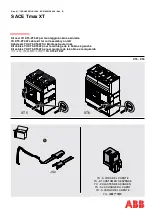
Effective 8/13/99
Page 8
I.L. 70C1037H02
When the functional protection settings are exceeded, the
Digitrip unit supplies a trip signal to the Trip Actuator. As a
result, all tripping operations initiated by the protection
functions of the Digitrip Trip Unit are performed by its
internal circuitry. There is no mechanical or direct mag-
netic action between the primary current and the me-
chanical tripping parts of the breaker, and external control
power is not required.
WARNING
IMPROPER POLARITY CONNECTIONS ON THE TRIP
ACTUATOR COIL WILL DEFEAT THE OVERLOAD
AND SHORT CIRCUIT PROTECTION, WHICH COULD
RESULT IN PERSONAL INJURY.
OBSERVE POLARITY MARKINGS ON THE TRIP
ACTUATOR LEADS AND CONNECT THEM PROP-
ERLY, USING THE INSTRUCTIONS PROVIDED.
2.2 Low-Energy Trip Actuator
The mechanical force required to initiate the tripping
action of a Magnum Circuit Breaker is provided by a
special low-energy Trip Actuator. The Trip Actuator is
Figure 2.1 Tripping Circuit for a Typical Magnum Breaker (Partial)
located under the black molded platform on which the
Digitrip unit is supported. The Trip Actuator contains a
permanent magnet assembly, moving and stationary core
assemblies, a spring, and a coil. Nominal coil resistance
is 25 ohms and the black lead is positive. The circuit
breaker mechanism assembly contains a
mechanism-actuated reset lever and a trip lever to
actuate the tripping action of the circuit breaker.
When the Trip Actuator is reset by the operating mecha-
nism, the moving core assembly is held in readiness
against the force of the compressed spring by the perma-
nent magnet. When a tripping action is initiated, the low-
energy Trip Actuator coil receives a tripping pulse from
the Digitrip unit. This pulse overcomes the holding effect
of the permanent magnet, and the moving core is re-
leased to trigger the tripping operation via the trip lever.
2.3 Ground Fault Protection
NOTE: The Digitrip Model 220 is not available with
ground fault protection. Only the 520 family has ground
fault types available.

































